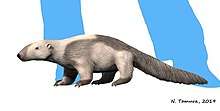Metacheiromys
Metacheiromys is an extinct genus of mammal from the Middle Eocene of what is now Wyoming.

| Metacheiromys | |
|---|---|
 | |
| Metacheiromys tatusia skeleton. | |
| Scientific classification | |
| Kingdom: | |
| Phylum: | |
| Class: | |
| Order: | |
| Family: | †Metacheiromyidae |
| Genus: | †Metacheiromys Wortman, 1903 |
| Species | |
| |
Metacheiromys was a small creature, and measured around 45 centimetres (18 in) long. It had long claws and a narrow head similar in shape to that of an armadillo or an anteater (though it was actually related to the modern pangolins). The shape of its claws suggests that it probably dug through the soil in search of food, most likely small invertebrates. Unlike modern anteaters or pangolins, it had powerful canine teeth, but only a very few cheek teeth, instead using horny pads in its mouth to crush its food.[2]
The generic name means "next to Cheiromys" because the scientist who saw the bones mistakenly thought that the animal was a primate with hands like those of the aye-aye, Daubentonia madagascariensis, one synonym being Cheiromys.
Metacheiromys and its relatives, including the enigmatic Ernanodon, constitute the order Palaeanodonta, thought to be the sister taxon of pangolins.[1]
References
- Kondrashov, Peter; Agadjanian, Alexandre K. (2012). "A nearly complete skeleton of Ernanodon (Mammalia, Palaeanodonta) from Mongolia: morphofunctional analysis". Journal of Vertebrate Paleontology. 32 (5): 983–1001. doi:10.1080/02724634.2012.694319.
- Palmer, D., ed. (1999). The Marshall Illustrated Encyclopedia of Dinosaurs and Prehistoric Animals. London: Marshall Editions. p. 206. ISBN 1-84028-152-9.